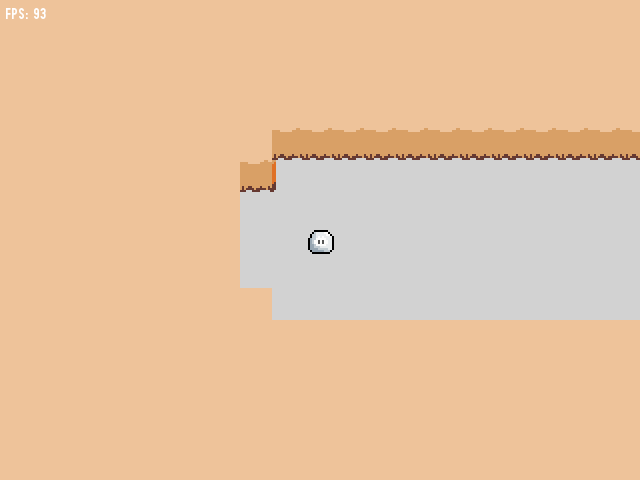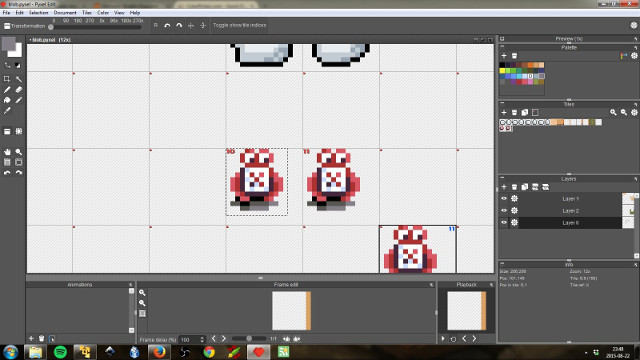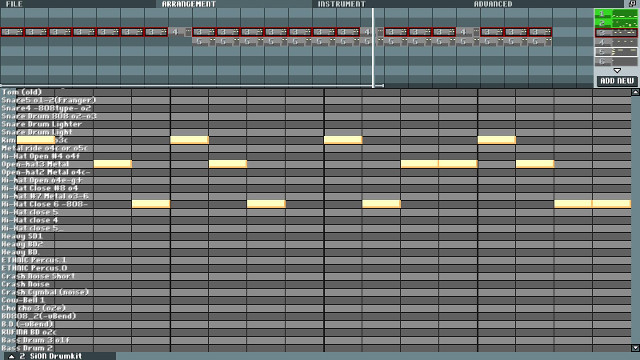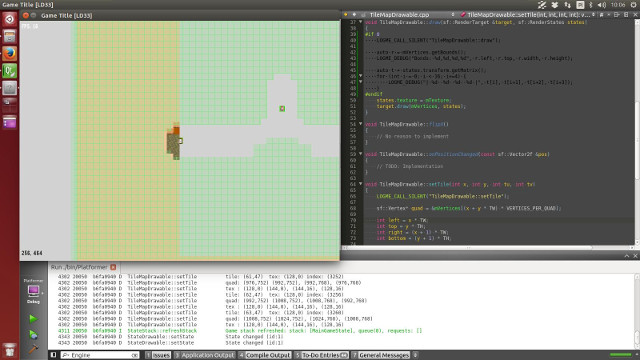Ludum Dare 33 — Ghosty Game
Published:
- gamedev
- imported
- ludum-dare
This article is an imported set of post from Ludum Dare website in which I'm describing my participation in Ludum Dare 33. It consists of 3 parts: Day 0 - before joining the event, Day 1 - thoughts at the end of first day and final thoughts to summarize whole event.
I'm in for the 2nd time
Posted: 2015-08-06
Hello fellow gamedevs!
My first time at Ludum Dare was a great experience and I really wanted to participate again. And I’ve got opportunity to join this time!
My goals for this edition are quite similar to the previous ones:
- Finish a playable game. That’s everyone’s main goal, so not much to say.
- This time I want to focus on introducing concept of the game to the player, so he or she won’t get lost. Last time it was a total failure. Players didn’t know what was the goal of the game, nor how to control the avatar, nor what are rules to the game.
- Keep visual simple, but of decent quality. If the topic is right I might even try to use a really simple shapes (circles and rectangles). The main focus is going to be on a good mix of colors, and little things like gradients and shadows. Last time I spent too much time creating unused animation.
- More fx sounds. Sound is a great tool for the feedback and to make the game feel alive. I hope I won’t mess the API this time and use the valid volume ranges (0-100 instead of 0-1). My tool of use: probably sfxer.
- Music. Any music. I’m not a musican at all, but since the beginning of this year I’ve been working in the audio/DSP related project. If it’s possible I’ll borrow MIDI keyboard from my company for the weekend to motivate me. The tool of use is going to be Milky Tracker, unless I find something easy to use.
- I have no idea what theme is going to win, but if possible I’m gonna try to make something fast-paced. Last time I tried to make clone of “Ugh!” game. This time again I’m gonna stick to already explored concepts. It’s still to early to me to create anything original, I’d rather focus my work in other fields.
I’ll stick to the tools I know well, so once again game is going to be done in C++11 and SFML with Box2D or Lua, depending on the theme.
I wish you all good luck at the LD33!
Day 1
Posted: 2015-08-22
Hello Ludum Dare-ers! I hope you're enjoying both compo and the theme. Day 1 is almost done so let me summarize my work today:
Finished:
- Testing custom engine for the first time; not working perfectly, but not as bad as the last time.
- Main character animations and some static assets
- Integration with Box2D. Tons of stupid issues to resolve. Good lesson.
- Loading level from .png files.
TODO for Day 2:
- Enemies: path finding, very simple AI
- More gfx/sfx assets
- Rendering optimizations and fixes
- Juicing the game up (screen shakes, explosions!)
- Design more levels and simple plot structure
- Come up with the title...
Not sure what's going to be dropped. I guess it's the music and more polished assets again.

Post mortem
Posted: 2015-09-19
Results of Ludum Dare 33 got already published so it's time for postmortem.
My main goal — making the game in time for the Compo — has not been acomplished. I was far from having anything ready to be send and the deadline has been reached. After getting some sleep, rest and spending time with family I decided not to give up completely and try to drive the game to the finish line called Jam.
For these readers who have no clue what's the difference between LD Compo and Jam, in short:
- Time to post entry to the compo is 48h, while for Jam it's 72h
- You are only allowed to work solo in the Compo, but for Jam you might work in a team made of programmers, gfx artists, musicans, etc.
- For Compo you must create all in–game assets (graphics, audio) by yourself and all of these need to be made during the 48h of the Compo. For Jam you are allowed to use already existing assets.
- Compo is very strict and limiting, while Jam is more careless
Results
.---------------.-----------------.-----------------.
| | LD 30 | LD 33 |
| Category | | |
| | Score | Place | Score | Place |
+---------------+------- +--------+--------+--------+
| Overall | 2.79 | 950 | 3.00 | 716 |
| Audio | 2.19 | 816 | 2.41 | 623 | Good job, minion!
| Fun | 2.85 | 730 | 3.11 | 485 |
| Graphics | 2.85 | 727 | 2.94 | 734 | ,
| Humor | 2.67 | 354 | ---- | --- | |
| Innovation | 2.44 | 1022 | 2.53 | 873 | ] |.-._
| Mood | 2.75 | 766 | ---- | --- | \|"(0)"| _]
| Theme | 2.33 | 1056 | 2.31 | 1049 | `|=\#/=|\/
`---------------'--------'--------'--------'--------' : _ :
\/_\/
|=|
`-' fsc
The results are generally better. Keep also in mind that in LD Jam you compete against teams of people, not the lone designers; it's much harder to get better score due to this single fact. I was really suprised that my overall score is that high as the game was far from being finished.
In the other hand, I've been slowly working on enhancing my graphics and audio skills and it seems like some progress has been made.
Timelapse
What went right
Visuals
I'm really happy that my pixel–art skills got improved. I was able to create some animations and (for a beginner) decent looking characters. However, there is still much more room for improvements. My next goal is to have enough skills to produce content of similar quality to the Ultimate Fantasy tileset.
 Working on the assets
Working on the assets
Audio
Music. I've finally made it! The tool of use was Bosca Ceoil. I was using it for the first time. Bosca Ceoil is an awesome tool to create simple tunes using tons of different samples. I think it's good idea to stick to this program for a now and focus on something else.
 Bosca Ceoil music editor
Bosca Ceoil music editor
Entity Component System
Before the LD I was working on my custom engine, based on ECS architecture. I had no actual game to test if it works properly, so LD was a first test. There were nasty bugs that took some time from my developement, mostly related to initialization as I was reusing preallocated memory for component data, but overall I'm really happy with the architecture. If you start thinking with components and not game objects, everything magically starts working. If you got your rendering, physics and audio systems already prepared you might focus on actual gameplay because attaching proper components will make everything magically work! This is the reason why people use engines like Unity. Few hours later you got working prototype.
What went left
Deadline missed
I was unable to deliver in time an entry for compo. I've lost over 6 hours of development due to a basic indexing issue which shouldn't happen to any software engineer. I didn't have any physic system ready to be used so I had to make one by myself. This combined with not tested ECS–engine resulted in too much time spent in a debugger trying to figure out what's going on. Lesson (I hope) learnt and (I hope) next time I'll focus more on actual gameplay.
Lack of actual gameplay
This is a big loss. As I've lost too much time fighting windmills, only single planned gameplay feature has been implemented. My plan was to create a stealth evasion game with static obstacles, moving enemies with their cone of view, sound alarm system, bullet hell and simple logic puzzles (push this button to activate that). To me this game is far from being playable. No idea where the 3.0 overall rating came from, but it's kind of intresting.
Lesson to learn
Just one lesson but the most important one: be focused on all the little things in a software development process…
… such as table indices or early function exits, as they may screw your
mind when you try to debug complex logics. If you name variables, even
for side projects such as LD entries, use good naming convention.
I've spend over 6h because I couldn't find the mistake in 2d → 1d array
index conversion; I've used wrong variable to determine size of the
row (tile's width in pixels instead of number of tiles in
a row). It could have been avoided if I hadn't had variables named TW
(Tile Width) and WW (World Width). When participating in LD, you
should have proffesional mindset too.
 Debugging index bug described above
Debugging index bug described above
The second bug, that cost me some time, was a removal of early function exit when calculating a direction from velocity vector. Due to refactoring I removed early exit on a vector length check. It resulted in division by 0, which for floats results in NaN, which resulted in wrong position of the player's character, which resulted in a camera moved to strange position, which resulted in a whole game state layer not being drawn and since I was using state-stack design, the MainMenu state got drawn, which resulted in lost hours in a debugger trying to figure out what the heck just happened.
The other lesson from this bug is: use asserts whenever you can.
For release mode they will be removed. Which leads to the third bug:
putting logic in a preprocessor macro which happen to be removed (changed
to do {} while(0)) in the release mode. My only explanation is a tiredness.
Plans for the future
Next Ludum Dare in 3 months so there's plenty of time for self–development and engine improvements. Right now I'm trying to make my new game project to get off the ground. As for the programming tasks, I've made the list of things to be done:
- Add more features to the mve-engine
- Cinematics
- Animators
- Shaders and processing effects (optional)
- Input rebinding (optional)
- Dynamic audio system (optional)
- Prepare level parser to be used
- Parse image (png) based maps
- Parse PyxelEdit txt format
- Parse Tiled map format (optional)
- Implement algorithm to reduce unnecessary number of rigid bodies when loading a map
- Prepare for LD34 (12-14 Dec, 2015)
- Continue improving on pixel arts